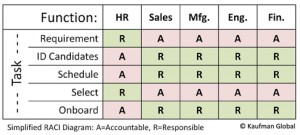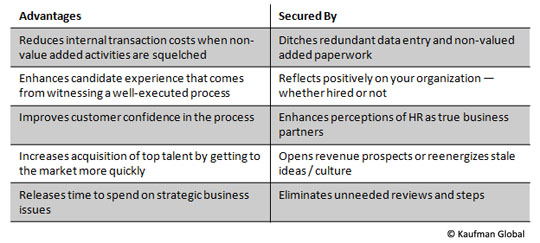Time To Hire: How To Improve Cycle Time
Talent Wars
You identify a critical resource need. A job requisition is prepared and submitted. The recruiting and hiring process begins. Perhaps six weeks later — if all goes well — your offer for employment is accepted and you have a new employee! Meanwhile, tasks for the new employee linger, workloads are out of balance, and opportunities are lost. Not having the right people in the right place at the right time can make or break your mission. Hiring is one of the most critical, yet least addressed, processes in many organizations. Time to hire is your metric.
Just like any other process, the lead time to hire can be improved within any organization and often drives big gains. The average time to fill a position over multiple industries is between 37 to 50 days. Imagine how much could be gained by shaving a modest seven days from that figure. All other things being equal, a seven-day improvement would speed-up that part of your business by 16%!
With today’s ultra-competitive landscape, the importance of acquiring top resources quickly is widely recognized. TTH (time-to-hire, often also termed time-to-fill) is the key metric for that. TTH tracks the span time it takes for a company to open a requisition to a qualified candidate who accepts an offer. But, improving this critical measure is often easier said than done because it requires a concerted effort across multiple functions.
The Time To Hire Fix
Attempts to reduce TTH are often led by the HR department. And, it’s true that they have an important role in process standardization and stewardship. Yet, lasting solutions are generally realized when a broad cross-section of the organization is engaged in process re-design because there are functional specifics that must be considered and integrated. It comes down to engaging the right folks with an informed viewpoint who can see and eliminate waste in their own domains.
For example, in decomposing TTH processes, we often encounter redundant steps, unneeded reviews and signoffs, and, gaps in communication and information flow that detract from speed and quality. Proper facilitation and making the most in applying process improvement tools is vital to move the needle on these characteristics.  That may mean completing a detailed process map, a RACI diagram (see simplified example to the right), a hand-off map, piloting policy changes, or, identifying practical metrics.
That may mean completing a detailed process map, a RACI diagram (see simplified example to the right), a hand-off map, piloting policy changes, or, identifying practical metrics.
Remarkably, actual process redesign might take only a week for a tightly focused, cross-functional team with a solid charter and strong sponsorship (again, cross-functional). However, once the future state has been described, the real work of implementation begins. This is where workgroup participation, visible metrics and continuing facilitation become crucial.
Integrate and Conquer
The “opportunity gain” of having critical resources in place sooner is just one of several beneficial TTH improvement outcomes. Other advantages are identified in the table below.
The business case for improving TTH is compelling, yet the technical approach isn’t that complex. Why then is this type of initiative often overlooked? It’s often the case that when something becomes “cross-functional” the organization freezes. Any thought of integration — even for a short time — to solve a big problem can be met with resistance. Don’t let the fact that multiple departments and functions need to be involved slow you down. Instead, embrace it! It can be accomplished. Effective planning, thoughtful communications and proven tools are your keys to success — always with your gaze on the next goal line.
How many days does it take your company to find, interview and hire the right candidate? What do you think is your biggest obstacle?

